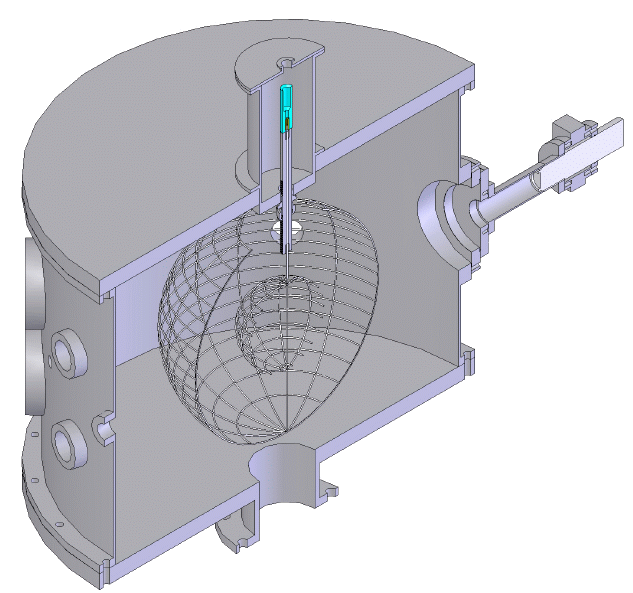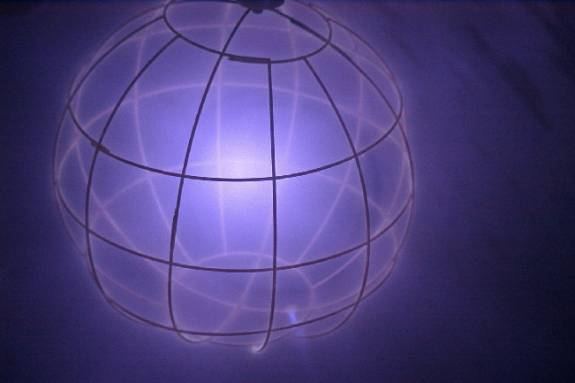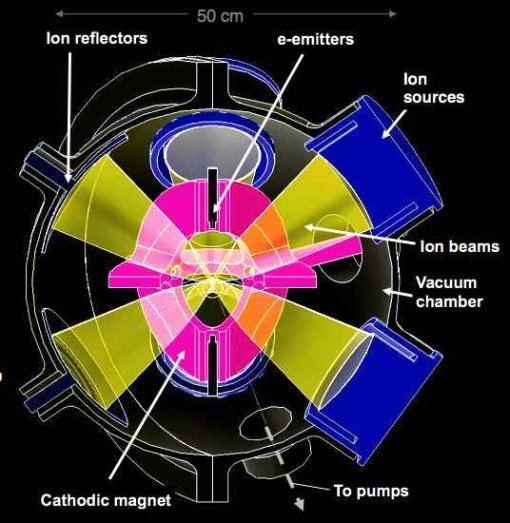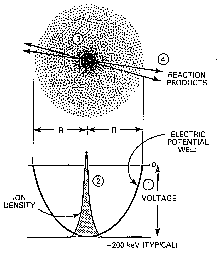 | ||
Inertial electrostatic confinement fusion reactor mk ii
Inertial electrostatic confinement is a branch of fusion research which uses an electric field to heat a plasma to fusion conditions. Electric fields can do work on charged particles (either ions or electrons), heating them to fusion conditions. This is typically done in a sphere, with material moving radially inward, but can also be done in a cylindrical or beam geometry. The electric field can be generated using a wire grid or a non-neutral plasma cloud.
Contents
- Inertial electrostatic confinement fusion reactor mk ii
- Demo inertial electrostatic confinement nuclear fusion reactor
- Mechanism
- 1930s
- 1950s
- 1960s
- 1980s
- 1990s
- 2000s
- 2010s
- Fusor
- POPS
- Designs with fields
- Polywell
- Penning trap
- Marble
- MIX
- Magnetically Insulated
- General criticism
- Thermalization
- Radiation
- Core focus
- Brillouin limit
- Commercial applications
- Government and commercial
- Universities
- Amateur
- Patents
- References

Demo inertial electrostatic confinement nuclear fusion reactor
Mechanism

For every volt that an ion is accelerated across, it gains 11,604 kelvins. For example, a typical magnetic confinement fusion plasma is 15 keV, or 170 megakelvin. An ion with a charge of one can reach this temperature by being accelerated across a 15,000 V drop. In fusors, the voltage drop is made with a wire cage. However high conduction losses occur in fusors because most ions fall into the cage before fusion can occur. This prevents current fusors from ever producing net power.
1930s

Mark Oliphant adapts Cockcroft and Walton's particle accelerator at the Cavendish Laboratory to create Tritium and Helium-3 by nuclear fusion.
1950s

Three researchers at LANL including Jim Tuck first explored the idea, theoretically, in a 1959 paper. The idea had been proposed by a colleague. The concept was to capture electrons inside a positive cage. The electrons would accelerate the ions to fusion conditions.

Other concepts were being developed which would later merge into the IEC field. These include the publication of the Lawson criterion by John D. Lawson in 1957 in England. This puts on minimum criteria on power plant designs which do fusion using hot Maxwellian plasma clouds. Also, work exploring how electrons behave inside the Biconic cusp, done by Harold Grad group at the Courant Institute in 1957. A biconic cusp is a device with two alike magnetic poles facing one another (i.e. north-north). Electrons and ions can be trapped between these.
1960s
In his work with vacuum tubes, Philo Farnsworth observed that electric charge would accumulate in regions of the tube. Today, this effect is known as the Multipactor effect. Farnsworth reasoned that if ions were concentrated high enough they could collide and fuse. In 1962, he filed a patent on a design using a positive inner cage to concentrate plasma, in order to achieve nuclear fusion. During this time, Robert L. Hirsch joined the Farnsworth Television labs and began work on what became the fusor. Hirsch patented the design in 1966 and published the design in 1967. The Hirsch machine was a 17.8 cm diameter machine with 150 kV voltage drop across it and used ion beams to help inject material.
Simultaneously, a key plasma physics text was published by Lyman Spitzer at Princeton in 1963. Spitzer took the ideal gas laws and adapted them to an ionized plasma, developing many of the fundamental equations used to model a plasma. Meanwhile, Magnetic mirror theory and direct energy conversion was developed by Richard F. Post's group at LLNL. A magnetic mirror or magnetic bottle, is similar to a biconic cusp except that the poles are reversed.
1980s
In 1980 Robert W. Bussard developed a cross between a fusor and magnetic mirror, the polywell. The idea was to confine a non-neutral plasma using magnetic fields. This would, in turn, attract ions. This idea had been published previously, notably by Oleg Lavrentiev in Russia. Bussard patented the design and received funding from Defense Threat Reduction Agency, DARPA and, Navy to develop the idea.
1990s
Bussard and Nicholas Krall published theory and experimental results in the early nineties. In response, Todd Rider at MIT, under Lawrence Lidsky developed general models of the device. Rider argued that the device was fundamentally limited. That same year, 1995, William Nevins at LLNL published a criticism of the polywell. Nevins argued that the particles would build up angular momentum, causing the dense core to degrade.
In the mid-nineties, Bussard publications prompted the development of a fusors at the University of Wisconsin–Madison and at the University of Illinois at Urbana–Champaign. Madison's machine was first built in 1995 and the group still produces some of the best IEC research in the world. Dr George H. Miley team at Illinois, built a 25 cm fusor which has produced 107 neutrons using deuterium gas and discovered the "star mode" of fusor operation in 1994. The following year, the first "US-Japan Workshop on IEC Fusion", was conducted. This is now the premier conference for IEC researchers. At this time in Europe, an IEC device was developed as a commercial neutron source by Daimler-Chrysler Aerospace under the name FusionStar. In the late nineties, hobbyist Richard Hull began building the first amateur fusors in his home in Virginia. In March 1999, he achieved a neutron rate of 105 neutrons per second. Hull and Paul Schatzkin, started fusor.net in 1998. Through this open forum, a community of amateur fusioneers have done nuclear fusion using homemade fusors.
2000s
Despite demonstration in 2000 of 7200 hours of operation without degradation at high input power as a sealed reaction chamber with automated control the FusionStar project was cancelled and the company NSD Ltd was founded. The spherical FusionStar technology was then further developed as a linear geometry system with improved efficiency and higher neutron output by NSD Ltd. which became NSD-Fusion GmbH in 2005. In early 2000, Dr. Alex Klein, developed a cross between a polywell and ion beams. Using Gabor lensing Dr. Klein attempted to focus plasma into non-neutral clouds for fusion. He founded FP generation, which in April 2009, raised $3 million in financing from two venture funds. The company developed the MIX and Marble machine, but ran into technical challenges and closed. In response to Riders' criticisms, researchers at LANL reasoned that a plasma oscillating could be at local thermodynamic equilibrium, this prompted the POPS and penning trap machines. At this time, researchers at MIT became interested in fusors for space propulsion and powering space vehicles. Specifically, researchers developed fusors with multiple inner cages. In 2005, Greg Piefer graduated from Madison and founded Phoenix Nuclear Labs a company which developed the fusor into a neutron source for the mass production of medical isotopes.
Robert Bussard began speaking openly about the Polywell in 2006. He attempted to generate interest in the research, before passing away from multiple myeloma in 2007, at the age of 79. His company was able to raise over ten million in funding from the US Navy in 2007, 2008 and 2009. In 2008, Taylor Wilson achieved notoriety for achieving nuclear fusion at 14, with a homemade fusor. He presented this work at two TED conferences, a science fair hosted by the white house, the Intel Science Talent Search and the Google Science Fair.
2010s
Bussard's publications prompted the University of Sydney to start research into electron trapping in polywells in 2010. The group has explored theory, modeled devices, built devices, measured trapping and simulated trapping. These machines were all low power and cost and all had a small beta ratio. In 2010, Carl Greninger founded the north west nuclear consortium, an organization which teaches nuclear engineering principles to high school students, using a 60 kvolt fusor. In 2012, Mark Suppes received attention, in Brooklyn for doing fusion with a fusor. Mark also measured electron trapping inside a polywell. Mr. Suppes was interviewed on CNN, and presented at 2012 WIRED conference and 2012 lift conference. In 2013, the first IEC textbook was published by George H. Miley. In 2014, Jamie Edwards, 13, was covered by international press as having fused the atom, however, he has not proved this to the amateur community - fusor.net - at the time of writing. (6/4/2014). Nonetheless, he received a letter of congratulations from HRH the Duke of York. Jamie also appeared the Late Show with David Letterman, to discuss his device. In early 2013 NSD-Fusion was acquired by Gradel sárl (LU) and has been enjoying increased sales of its compact sealed tube IEC NSD-Gradel-Fusion neutron generators.
In August 2014, Phoenix Nuclear Labs announced it had a high yield neutron generator available for sale. This device used an electric field to heat ions to fusion conditions. The device cost on the order of millions of dollars and could sustain 5E+11 neutrons per second, for a 24-hour period. In January 2015, the polywell was presented at Microsoft Research.
Fusor
The best known IEC device is the fusor. This device typically consists of two wire cages inside a vacuum chamber. These cages are referred to as grids. The inner cage is held at a negative voltage against the outer cage. A small amount of fusion fuel is introduced (deuterium gas being the most common). The voltage between the grids causes the fuel to ionize. The positive ions fall down the voltage drop towards the negative inner cage. As they accelerate, the electric field does work on the ions, heating them to fusion conditions. If these ions collide, they can fuse. Fusors can also use ion guns rather than electric grids. Fusors are popular with amateurs, because they can be easy to construct, can regularly produce fusion and are a practical way to study nuclear physics. Fusors have also been used as a commercial neutron generator for industrial applications.
No fusor has come close to producing a significant amount of fusion power. They can be dangerous if proper care is not taken because they require high voltages and can produce harmful radiation (neutrons and x-rays). Often, ions collide with the cages or wall. This conducts energy away from the device limiting its performance. In addition, collisions heat the grids, which limits high power devices. Collisions also spray high-mass ions into the reaction chamber, pollute the plasma and cool the fuel.
POPS
In examining non-thermal plasma, workers at LANL realized that scattering was more likely than fusion. This was due to the coulomb scattering cross section being larger than the fusion cross section. In response they built POPS, a machine with a wire cage, where ions are moving at steady-state, or oscillating around. Such plasma can be at local thermodynamic equilibrium. The ion oscillation is predicted to maintain the equilibrium distribution of the ions at all times, which would eliminate any power loss due to Coulomb scattering, resulting in a net energy gain. Working off this design, researchers in Russia simulated the POPS design using Particle-in-cell code in 2009. This reactor concept becomes increasingly efficient as the size of the device shrinks. However, very high transparencies (>99.999%) are required for successful operation of the POPS concept. To this end S. Krupakar Murali et al., suggested that carbon nanotubes can be used to construct the cathode grids. This is also the first (suggested) application of carbon nanotubes directly in any fusion reactor.
Designs with fields
Several schemes attempt to combine Magnetic Confinement and electrostatic fields with IEC. The goal is to eliminate the inner wire cage of the fusor, and the resulting problems.
Polywell
The polywell uses a magnetic field to trap electrons. When electrons or ions move into a dense field, they can be reflected by the magnetic mirror effect. A polywell is designed to trap electrons in the center, with a dense magnetic field surrounding them. This is typically done using six electromagnets in a box. Each magnet is positioned so their poles face inward, creating a null point in the center. The electrons trapped in the center form a "virtual electrode" Ideally, this electron cloud accelerates ions to fusion conditions.
Penning trap
A Penning trap uses both an electric and magnetic field to trap particles. A magnetic field to confine particles radially and a quadrupole electric field to confine the particles axially. In the 1990s, researchers at LANL build a penning trap to do fusion experiments. Their device (PFX) was a small (millimeters) and low power (one fifth of a Tesla, less than ten thousand volts) machine. The magnetic and electric fields are turned on. Electrons are emitted into the trap, caught and measured. Ideally, fusion schemes using Penning traps can hold in electrons which would then attract ions, accelerating them to fusion conditions.
Marble
MARBLE (which stood for: multiple ambipolar recirculating beam line experiment) was a device which moved electrons and ions back and forth in a line. Particle beams were reflected using electrostatic optics. These optics made static voltage surfaces in free space. Such surfaces reflect only particles with a specific kinetic energy, while higher-energy particles can traverse these surfaces unimpeded, although not unaffected. Electron trapping and plasma behavior was measured by Langmuir probe. Marble kept ions on orbits that do not intersect grid wires—the latter also improves the space charge limitations by multiple nesting of ion beams at several energies. Researchers encountered problems with ion losses at the reflection points. Ions slowed down when turning, spending lots of time there, leading to high conduction losses.
MIX
The multipole ion-beam experiment (MIX) accelerated ions and electrons into a negatively charged electromagnet. Ions were focused using Gabor lensing. Researcher had problems with a very thin ion turning region very close to a solid surface where ions could be conducted away.
Magnetically Insulated
Devices have been proposed where the negative cage is magnetically insulated from the incoming plasmas.
General criticism
In 1995, Todd Rider critiqued all fusion power schemes using plasma systems not at thermodynamic equilibrium. Rider assumed that plasma clouds at equilibrium had the following properties:
Rider argued that if such as system was sufficiently heated, it could not be expected to produce net power, due to high x-ray losses.
Other fusion researchers such as Nicholas Krall, Robert W. Bussard, Norman Rostoker and Monkhorst disagreed with this assessment. They argue that the plasma conditions inside IEC machines are not quasineutral and have non-thermal energy distributions. Because the electron has a mass and diameter much smaller than the ion, the Electron temperature can be several orders of magnitude different than the ions. This may allow the plasma to be optimized, whereby cold electrons would reduce Radiation losses and hot ions would raise Fusion rates.
Thermalization
The primary problem that Rider has raised is the thermalization of ions. Rider argued that, in a quasineutral plasma where all the positives and negatives are distributed equally, the ions will interact. As they do, they exchange energy, causing their energy to spread out (in a Wiener process) heading to a bell curve (or Gaussian function) of energy. Rider focused his arguments within the ion population and did not address electron-to-ion energy exchange or non-thermal plasmas.
This spreading of energy causes several problems. One problem is making more and more cold ions, which are too cold to fuse. This would lower output power. Another problem is higher energy ions which have so much energy that they can escape the machine. This lowers fusion rates while raising conduction losses, because as the ions leave, energy is carried away with them.
Radiation
Rider estimated that once the plasma is thermalized the radiation losses would outpace any amount of fusion energy generated. He focused on a specific type of radiation: x-ray radiation. A particle in a plasma will radiate light anytime it speeds up or slows down. This can be estimated using the Larmor formula. Rider estimated this for D-T (deuterium-tritium fusion), D-D (deuterium fusion), and D-He3 (deuterium-helium 3 fusion), and that breakeven operation with any fuel except D-T is difficult.
Core focus
In 1995, Nevins argued that such machines would need to expend a great deal of energy maintaining ion focus in the center. The ions need to be focused so that they can find one another, collide and fuse. Over time the positive ions and negative electrons would naturally intermix because of Electrostatic attraction. This causes the focus to be lost. This is core degradation. Nevins argued mathematically, that the fusion gain (ratio of fusion power produced to the power required to maintain the non-equilibrium ion distribution function) is limited to 0.1 assuming that the device is fueled with a mixture of deuterium and tritium.
The core focus problem was also identified in fusors by Tim Thorson at the University of Wisconsin–Madison during his 1996 doctoral work. Charged ions would have some motion before they started accelerating in the center. This motion could be a twisting motion, where the ion had Angular momentum, or simply a tangential velocity. This initial motion causes the cloud in the center of the fusor to be unfocused.
Brillouin limit
In 1945, Columbia University professor Léon Brillouin, suggested that there was a limit to how many electrons one could pack into a given volume. This limit is commonly referred to as the Brillouin limited or Brillouin density, this is shown below.
Where B is the magnetic field,
Commercial applications
Since fusion reactions generates neutrons, the fusor has been developed into a family of compact sealed reaction chamber neutron generators for a wide range of applications that need moderate neutron output rates at a moderate price. Very high output neutron sources may be used to make products such as Molybdenum-99 and Nitrogen-13, medical isotopes, used for PET scans.
Government and commercial
Universities
Amateur
Amateurs mainly build fusors. Listed here are teams or machines which have produced neutrons.
